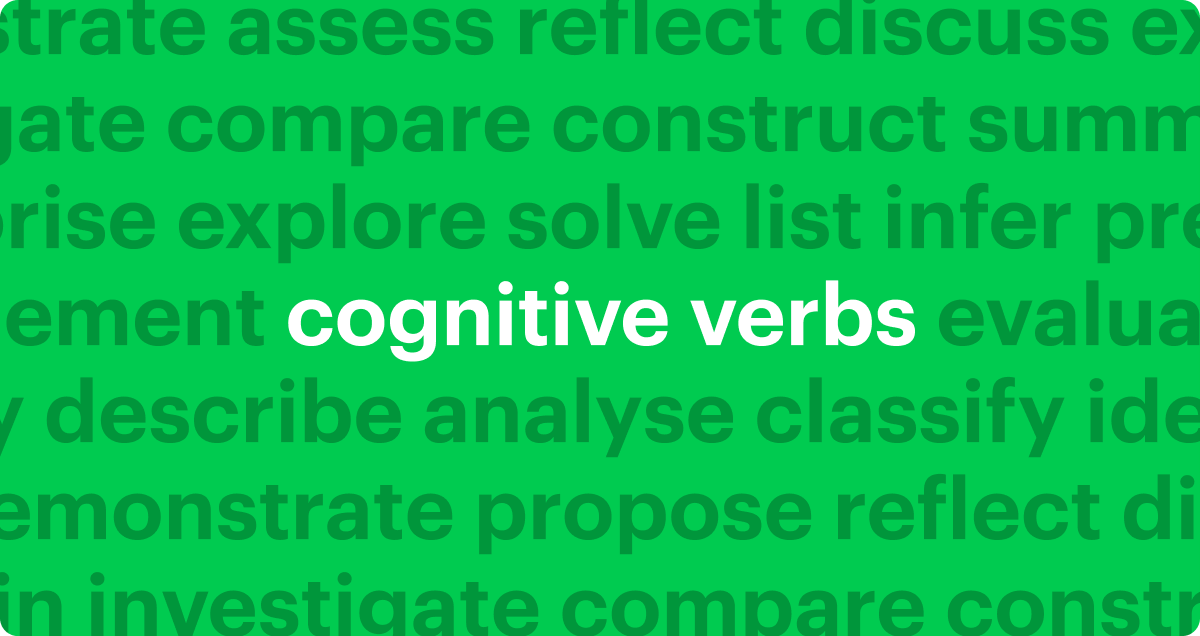Cognitive verbs in Stile

At Stile, we’re constantly reflecting on ways to improve the lessons and resources we provide to science teachers around Australia and the world. Every question in Stile now includes a cognitive verb to clearly inform students of the level of thinking required to answer the question. We’ve also created an accompanying skill builder that you can use to explicitly teach this important skill to your students. This change to our collection of lessons provides opportunities for explicit teaching and helps structure lessons that scaffold from lower- to higher-order questions.
What are cognitive verbs?
Cognitive verbs are essentially task words. They signal to students the depth of the question and how to go about answering it.
We’ve used cognitive verbs that fall across four levels of cognitive process.
- The first cognitive level requires basic recall. It includes words such as list, identify and state. These require students to only provide a small level of information in a task response.
- The second cognitive level requires students to have a basic understanding and to be able to identify several components of a task. It includes words such as describe, classify, summarize and distinguish.
- At the third cognitive level, students have a strong understanding and are able to connect, relate and integrate ideas relating to a task. This level includes cognitive verbs such as explain, infer, interpret, apply and analyse. Task words at this level generally require a much more detailed response.
- At the final cognitive level, students are able to apply their ideas to new contexts. At this level students are transferring ideas, problem-solving and generalising. This includes cognitive verbs such as predict, evaluate, judge, propose and justify.
There are several pedagogical models that align with the model we’ve used. This includes Marzano and Kendall’s (2007) four levels of cognitive process and the SOLO taxonomy. Comparisons can also be drawn to Bloom’s taxonomy, where the Evaluate and Create levels are merged into the fourth cognitive level.
Why use cognitive verbs and not Bloom’s levels of thinking?
You may remember that we had Bloom’s levels at the beginning of questions.
For example, our questions used to look like this:
Understand: Describe the function of the mitochondria.
Without Bloom’s levels, questions in Stile now look like this:
Describe the function of the mitochondria.
Although Bloom’s levels were useful for teachers to guide students through what was required to access the question, the teachers we spoke to ultimately found that having both Bloom's levels and cognitive verbs was confusing, and that cognitive verbs are more beneficial for students. Many teachers even reported deleting Bloom’s verbs altogether. When surveyed, 80% of Stile Previewers supported the change from Bloom’s levels to cognitive verbs. Removing Bloom’s levels should reduce cognitive overload for students by allowing them to focus on only the cognitive task words. This should help students narrow down which information to include in their response and in which way.
Impact on student learning
Explicitly teaching and familiarizing students with cognitive verbs in Years 7–10 helps to simplify the learning process. It assists students in decoding exactly what questions are asking of them. Moreover, building these skills across Years 7–10 will help prepare students for senior science, where they’ll need to demonstrate their understanding of these verbs in assessments.
Incorporating cognitive verbs into lessons helps with both structuring lessons, metacognition and explicit teaching. These are high-impact teaching strategies that have been shown to improve student outcomes (Hattie, 2009). Through our accompanying skill builder, we’ve also included an opportunity to incorporate explicit teaching.
Metacognition
Metacognition is having an awareness and understanding of your own thought processes, or, simply put, “thinking about thinking”. By teaching your students the meaning of cognitive verbs, they can then think about their own learning and recognise the information required to successfully answer the question. Incorporating metacognitive strategies into the classroom has shown to substantially improve student learning with an effect size of 0.69 (Hattie, 2009).
Structuring lessons
Part of a structured lesson ensures having appropriate scaffolding for students.
Scaffolding
Cognitive verbs assist with scaffolding a lesson. Lessons in Stile begin with lower-level questions, asking students to recall or identify basic facts. As the lesson progresses, questions become increasingly complex as reflected by higher-level cognitive verbs such as explain or justify. Scaffolding was identified by Hattie (2019) as having a moderate effect size of 0.53 on student learning.
Explicit teaching
Showing students what to do and how to do it helps to build student knowledge.
Teacher clarity
Cognitive verbs can be used to explicitly teach the requirements of the question. This can enhance teacher clarity by identifying exactly what a verb means, and how students are expected to respond and in which way. We’ve also designed a lesson type, skill builders, wholly to provide you with opportunities to teach skills. You could also use the Model Answers in Stile to teach what each cognitive verb requires. Hattie (2009) identified that teacher clarity has a strong, positive effect size of 0.75 on student learning.

We recommend that you begin explicitly teaching your students cognitive verbs from the start of the year. You can then build on this base knowledge and apply it in action across the rest of the school year. A really nice start to the year could be using our new skill builder that helps you do just that! View our Skill builder: Cognitive verbs here.
Pro tip: Key questions
Key questions make feedback more effective by identifying the questions that directly address the lesson’s learning intentions. The cognitive verb, and therefore the level of depth required in each key question, aligns with the learning intentions for the lesson. Read this article for more information.
References
Department of Education and Training, (2017). High Impact Teaching Strategies: Excellence in Teaching and Learning. Melbourne.
Hattie, J. (2009). Visible Learning: A synthesis of over 800 meta-analyses relating to achievement. Milton Park, UK: Routledge.
Marzano, R. J., & Kendall, J. S. (2007). The new taxonomy of educational objectives. Thousand Oaks, CA: Corwin Press.

